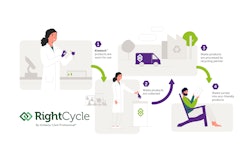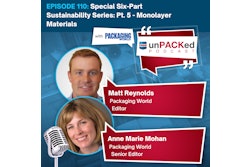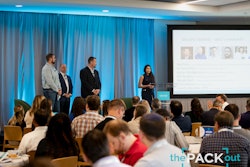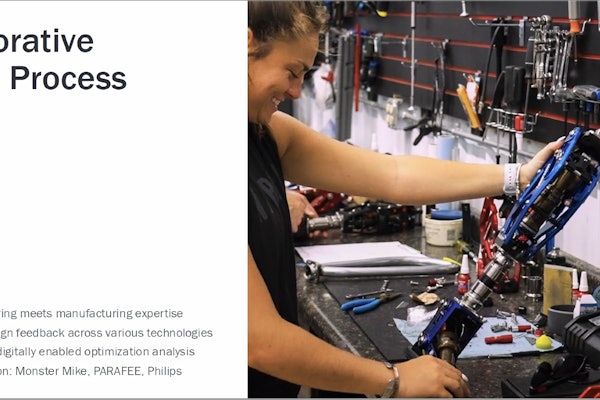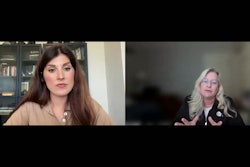The future is now in part six of unPaCKed’s six-part sustainability sit-down with Packaging World editors Anne Marie Mohan and Matt Reynolds. Bioplastics reads like an oxymoron, but the revolutionary new materials from renewable resources versus petroleum are indeed here to stay. Mohan and Reynolds cover sustainability and packaging materials daily and examine how sugar cane, corn, and even wood chips now find their way into packaging materials in lieu of traditional plastics.
Explore sustainable solutions at PACK EXPO Las Vegas this September 11-13. Registration is now open!
To subscribe, rate, review, and find more unPACKED podcast episodes, visit pmmi.org/podcast or find us on Apple Podcasts, Spotify, iHeart Radio, or wherever you listen to your podcasts.
Sean Riley:
So with all the fancy introductions out of the way, welcome back to the podcast, Matt Reynolds and Anne Marie Mohan. Matt, welcome.
Matt Reynolds:
Thanks for having me.
Sean Riley:
Anne Marie, welcome.
Anne Marie Mohan:
It's a pleasure to be here.
Sean Riley:
Pleasure is always mine. Today we're here to talk about bioplastics. And bioplastics first of all, as I say it out loud, sounds like a, one, an oxymoron, oxymoron, bio plastic. Anyway, they were going to be this silver bullet that was going to solve every problem. They were going to be the film, they were going to be the resin, they were going to be the things that we were going to use that was going to be renewable. And everybody was excited about it, whether it was 10, 15 years ago, and I feel like everyone started throwing their R&D budgets and things at it. So I guess to start, before we really get into it, why was that the case?
Anne Marie Mohan:
Well, one thing that really captured everyone's attention about bioplastics is that they're made from a renewable resource versus being made from petroleum. So they use sugar cane, they use corn, and now they're even using more cellulose feed stock like wood chips and things like that.
Sean Riley:
Oh, really? Okay.
Anne Marie Mohan:
So it's made from a renewable resource. And not only are they a renewable resource, but because they are, they're sequester carbon. So they take carbon in rather than emitting it. So that's another advantage. And as we moved along in the development of bioplastics, there came technology called drop-in plastics or bioplastics, where they have the same functionality and same properties as a petroleum based plastic. So with the early PLA or polylactic acid, which was the biggest thing to happen back in 2000 or so, the problem was that you could make the bottle, it didn't have the same properties, it was really sensitive to heat, and then it also would contaminate the recycling stream. But for a consumer, you couldn't really tell the difference in the bottle. So they'd just throw it in with the recycling. But with drop-in bioplastics, you have the same functionality, they can be recycled. And so that was a huge advancement in the technology.
Sean Riley:
Interesting. So that the good plastics would contaminate the bad plastics, essentially. Bad being my term for in the recycling team, but this stuff from natural resources, I guess, because it's not the same. Interesting. I wouldn't have thought of it that way. I guess I just figured it would fizzle out once it got to the recycling stream.
Matt Reynolds:
Yeah, functionally it's the same, but as soon as it gets to the merf, then that's where trouble occurs.
Sean Riley:
Right. The merf, there's a lot of trouble at the merf and we've understood that as we've done a series of these podcasts. All right, so this stuff is awesome. Why isn't it everywhere? Why are we not seeing it on every shelf? Why isn't it?
Matt Reynolds:
Well, I mean, one thing that's changed since you mentioned early 2000s is, plastics in general have just really taken a perception beating. So the focus and sustainability as it pertains to packaging is now the eye is cast on plastics and bioplastics are still plastics. They're still a kind of an alphabet soup of P E P E T L, all these kinds of letters that confuse consumers and scare consumers because they're not exactly sure how to recycle it. And as Anne Marie said, some of them can't be recycled. I think early on there was this misconception that because the bio's in the word, they assume they're biodegradable. So over the years we had to be real careful about defining what biodegradable is, just because it's bioplastic doesn't make it biodegradable necessarily. And the differences between compostability and backyard versus industrial compostability and biodegradability, these are all very kind of, it's venn diagrams that overlap a little bit, but they're not the same thing. So it's further confusing to the consumer. It costs more, bioplastics cost more. I mean, that's a line [inaudible 00:04:00]
Sean Riley:
Always the driver. Yes.
Matt Reynolds:
Yeah. So petroleum based virgin plastic is really high quality and it's super cheap the way it's made right now. And there's a lot of efforts right now to level that playing field and create some... Make sure that the finances or the economics isn't the only driver there. And there's some worry about, food is a worry. If bioplastics are coming from corn and from sugar cane, is that eating into the world's food supply?
Matt Reynolds:
Now, that's a genuine concern. I think since then we've realized that the percentage is really, really tiny. That's actually eating into what potentially could be food. And now as Anne Marie said, now you're starting to add cellulose non food cellulose food waste, or non food, which is wood chips or food waste, second post use food, essentially. I mean, imagine brewers giving up their barley or something like that. So that's not as much of a concern, but it was just one of many that pumped the brakes on what we thought in 2002 or something like that would be the silver bullet. And eating up R&D budget very slowly over the course of time is what's happened instead of it being some big immediate threshold moment. Yeah.
Sean Riley:
Okay. So I guess we use these last decade or whatever to, well, we didn't have to spend the R&D kind of fortunately, but now that they've ironed this all out and learned all this, are there some examples now that we have out there in the marketplace that are finding ways to apply this?
Anne Marie Mohan:
Absolutely. And one of the biggest suppliers of bioplastics that I'm aware of where we have really seen a lot of applications both in region and in flexible is Braskem. And they do a drop-in bioplastic, they do drop-in polyethylene, and we have several examples of what they're doing originally they were supplying part of the feed stock for Coca-Cola's plant bottle. They also work with the company in the UK to make a reusable bottle. So it was for tourists there who would get a water bottle and then just litter. So there was a lot of litter from tourists, and now you can get the bottle filled and then reuse it. It's a very durable recyclable and reusable package. So delicious almond milk is used for their packaging. There's a toothpaste tube from Ireland that's using the Braskem drop-in bioplastic. So yes, we definitely have the applications.
Sean Riley:
Now you say that Coca-Cola was using Braskem, were they not still? I remember, and I remember you just obviously saying 30 seconds ago, but I also remember reading this that they were using them and now it seems like, are you implying that they're not anymore?
Anne Marie Mohan:
Well, what's really exciting is just recently they were able to come up with or crack the code on engineering a completely bioplastic bottle, plant based bottle. So formerly they were using 30% bioplastic, and I don't know, it's been maybe 12 years that they've been developing this lot of R&D. And they switched, and I don't know exactly why they made the switch or they were looking for suppliers. They were investing in different companies, but now they're using 30% hardwood from forestry and sawmill side streams. And then 70% is now from corn and sugar cane, but it is not Braskem's. It's a different technology that they're using. And then at the same time, Suntory beverages also just announced that they have completed a 100% plant based bottle. Now in their case, they're using 30% material for molasses, which is very interesting. And they were doing that before. And then 70% is from non-food feed stock. So they both hit the finish line at the same time. But it's very exciting.
Sean Riley:
Yeah, that is. Now, for Coca-Cola for example, are they, I will admit, I don't drink a lot of soda. Is this just, I know I've seen it with the Dasani and stuff like that. Are they able to use this across their product line or is this just something that's something like a water... Does the different beverages have a different effect in the bottle? Or can they use their whole product line in these bottles?
Anne Marie Mohan:
My understanding is that they could use it across the bottles. Right now they're waiting for commercial scale up of this technology, but their goal really isn't to replace what they have now, it's to be another option. So they're trying to reach all these sustainability goals. And if I look at my notes here, they've said that their strategy is to use 70% to 80% recycled PET and then use advanced recycling and renewable materials for the other 30%. So they're not moving to plant-based, but it's an addition to.
Sean Riley:
Okay.
Matt Reynolds:
Another tool in the toolkit basically.
Sean Riley:
Yeah, I was going to say, so it's another way to meet a certain number or a certain goal, and I understand that. Okay. So I guess what I'm thinking is, are there other kinds of bioplastics besides these, I guess what we've been calling drop-ins, things that can go with PE or PET being used at the marketplace?
Matt Reynolds:
Yeah. There's a lot being done with starches, thermoplastics, or excuse me. Yeah, thermoplastic starches. I just covered one, I think it was a year ago now though. It was with Sealed Air and it was a pasta company out of Seattle called Cocina Fresca. Hopefully I'm pronouncing that correctly.
Sean Riley:
I feel like I've heard that before. Yes.
Matt Reynolds:
Possibly. Yeah. I mean, they sell it out of that Pike Place market or whatever. But the living material, it was a thermoplastic tray with pasta inside. And I don't remember if it was map, it could have been map modified atmosphere, but it was a matter of the living material turning to this thermoplastic starch. That was an interesting, And it wasn't the full amount, it was a percentage of it using it. But then on the subject of starches, there's also, a lot's being done with potatoes, potato starch, and there's a few different versions. One of them is Wada potato that uses resins. It's a biologiq, the logiq with a Q from new plastiq, plastiq with a Q. Sorry, I had to look at my notes for that.
Sean Riley:
I know, this stuff is new.
Matt Reynolds:
No, and it's, yeah, 20 to 30% of the pack itself, the pouch is from that TPS or a potato based starch. And then also Alexia potatoes from Lamb Weston are using a potato based starch in the pouch. So the interesting thing there is you've got potatoes in the pack and the pouch is made from potatoes in a sense, or at least a portion of it. So there's some circularity there.
Sean Riley:
I was going to say, yeah, that seems very circular, having potatoes in potatoes. So I guess are there, to put a button on this discussion with bioplastics, are there others out there that we haven't touched on? Because so far I have no idea about the potatoes. I didn't know about the wood and the cellulose. So I'm learning at least somebody out there is definitely learning along with me. So there are other ones out there that would be noteworthy that we should get out?
Matt Reynolds:
Well, I mentioned that one of the early misconceptions is that all bioplastics were biodegradable by nature and they're not. But as Anne Marie knows that at least one or two of them are. So I think one of them was...
Anne Marie Mohan:
Yes, there's a really exciting new technology that has been in development for quite a few years. And it's called PHA. The resin is called PHA, and I can't tell you, I know what it stands for, but I can't say it.
Matt Reynolds:
Polyhydroxyalkanoates
Anne Marie Mohan:
And it's made from a naturally occurring organism, which is one step beyond what we've been seeing. And what's really noteworthy about it is that it is marine biodegradable. One company that's been working with Danimer Scientific, which is one of the biggest companies that I'm aware of that's working on this technology is Frito Lay. And they just released a compostable package made from this PHA material. The product is off the Eaton pack. So some people may remember that years ago, Pepsi Co was really ahead of its time in creating compostable snack bags, but the problem at the time was that it was too loud. So they fixed that and so this is a very exciting development.
Sean Riley:
So that, yeah, they did get the sound out of Sun chips people were very unhappy that their potato chip bag or their sun chip bag, excuse me, was too loud, which in and of itself is hilarious because...
Matt Reynolds:
Priorities right?
Sean Riley:
Yeah, priorities and chip bags aren't exactly silent as anyone who's ever been in a movie theater would know.
Matt Reynolds:
And Bacardi's also using this technology too.
Sean Riley:
Bacardi?
Matt Reynolds:
Yeah. So it's big between Frito Lay and Bacardi, those are two big brands using this, Danimer Scientific.
Sean Riley:
Fantastic. And I guess to kind of wrap up, and again, I thank Anne Marie and Matt for your time. Is that one thing that you've said a lot, and I don't know that I've really highlighted or we've highlighted enough, is marine biodegradable. And from what I understand by saying that is that, that's something that in the end will not harm the ocean. Correct?
Matt Reynolds:
That's my understanding of it.
Sean Riley:
Right? Yeah. I mean, and that's the biggest thing with plastics. That's the biggest thing that we are always hearing, is that at the end of the day, yes, we see landfills and stuff like that, but then you see these pictures of these massive...
Matt Reynolds:
Flotilla's of plastics.
Sean Riley:
Yeah, Flotilla, thank you, of plastics out in the ocean. So that marine biodegradable is a huge thing that I know came up often and is really exciting so that we won't hopefully continue to harm the oceans in the future. So that would no longer be a drawback. So again, thank you Anne Marie, Thank you Matt, for joining us. And go out there and get some bioplastics.



